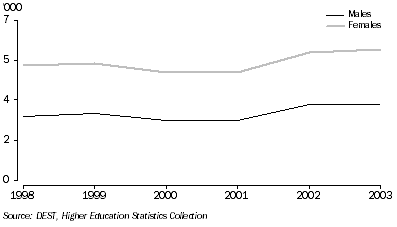Vocational education and training
The National Centre for Vocational Education Research (NCVER) reports that in 2003, approximately 58,000 Indigenous students were enrolled in VET courses, representing about 3% of the total student population. Indigenous males slightly outnumbered Indigenous females in 2003 (53% and 47% respectively). Over one-quarter (27%) of Indigenous VET students had a postal address in a remote region, compared with 3% of non-Indigenous VET students.
Indigenous VET enrolments increased between 1997 and 2002, before declining slightly in 2003 (table 3.5). The proportion of Indigenous students within the total VET population also increased over this time period.
3.5 Vocational education and training enrolments, Indigenous and all students - 1997-2003 |
|  |
 |  | 1997 | 1998 | 1999 | 2000 | 2001 | 2002 | 2003 |  |
|  |
| Indigenous | '000 | 38.5 | 44.1 | 50.3 | 50.7 | 56.1 | 59.7 | 58.1 |  |
| Non-Indigenous | '000 | 1 093.2 | 1 145.6 | 1 281.3 | 1 296.5 | 1 323.7 | 1 284.3 | 1 326.7 |  |
| Unknown | '000 | 317.4 | 320.2 | 283.0 | 360.7 | 299.3 | 338.9 | 333.0 |  |
| Total | '000 | 1 449.1 | 1 509.8 | 1 614.6 | 1 707.9 | 1 679.1 | 1 682.9 | 1 717.8 |  |
| Indigenous proportion of all students | % | 2.7 | 2.9 | 3.1 | 3.0 | 3.3 | 3.5 | 3.4 |  |
|  |
| National Centre for Vocational Education Research. Data available on request. |
Success in VET is ultimately dependent upon successful completion of modules. In 2003, the rate of VET module completions for Indigenous students was 65%, compared with 78% of the total VET student population.
Higher education
Unlike the VET sector, Indigenous students are under-represented in the higher education sector. Data from the Higher Education Statistics Collection show that Indigenous Australians comprised 1% of the total higher education population in 2003, with 9,000 students. This was the highest number of Indigenous higher education enrolments recorded between 1997 and 2003. However, the proportion of Indigenous students within the higher education population remained largely unchanged over this time period (at around 1%).
There was a notable gender imbalance among Indigenous higher education students in 2003, with females accounting for approximately two-thirds (63%) of all Indigenous students. As shown in graph 3.6, the gap between male and female enrolments has remained relatively unchanged since 1998.
3.6 Indigenous Higher Education Students - 1998-2003

 Print Page
Print Page
 Print All
Print All
 Print Page
Print Page
 Print All
Print All